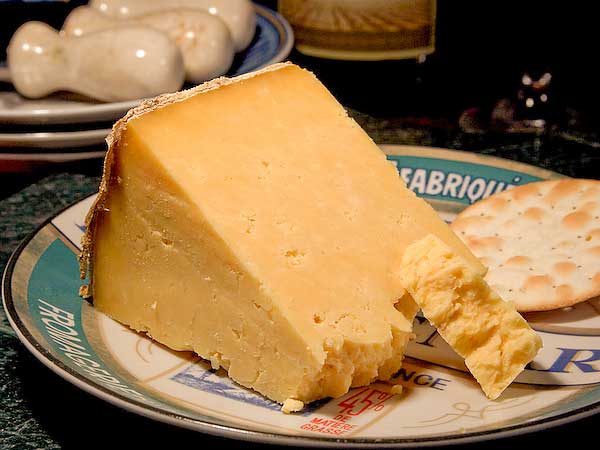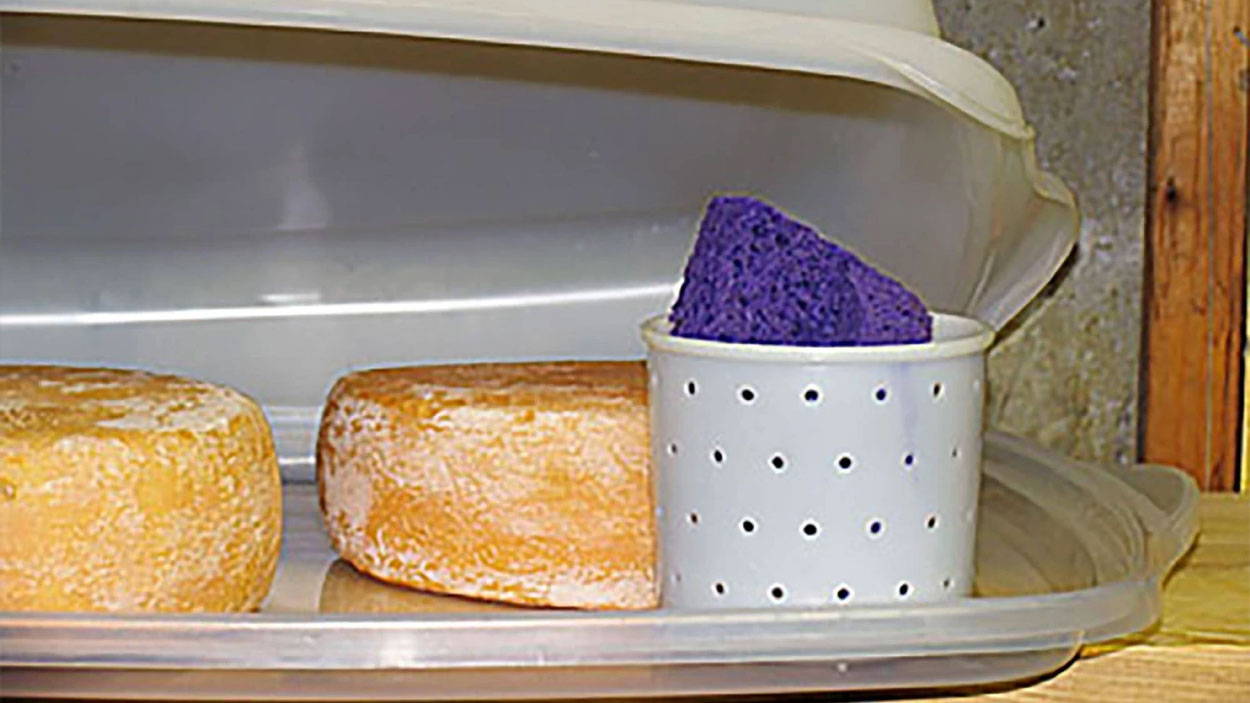
Cheshire Cheese Recipe
-
Yield
4 Pounds
-
Aging Time
~2 Months
-
Skill Level
Advanced
-
Author
Jim Wallace

Ingredients
Total price for selected items: Total price:
Instructions
-

Acidify & Heat Milk
Begin by heating the 4 gallons of milk to 86-88°F (30-31°C). Higher temp for higher fat milk.
You can do this best by placing the pot of milk in a larger pot or sink of very warm water. If you do this in a pot on the stove, make sure you heat the milk slowly and stir it well as it heats.Once the milk is at proper temperature the culture can be added.
1 pack of C101 Mesophilic Culture or 3/8 tsp MA11 (same as Cheddar) for fresh farm milk but increase this to 1/2 tsp if using pasteurized milk from the store.
Ripen 40-60 minutes. This is ripened less than Cheddar.
To prevent the powder from caking and sinking in clumps, sprinkle the powder over the surface of the milk and then allow about 2 minutes for the powder to re-hydrate before stirring it in.
Once the culture has been mixed in well, the color can be added. This is an extract from the Annatto tree. For a full color Cheshire, about 8-12 ml of the color should be added to the milk. It is best to mix this in a small volume of milk and then add that to the full batch.
This will not appear to be very dark, but since the color is held in the curd, the color will darken through the process as whey is released and the color concentrates. This initial milk/curd will be a nice golden color. (I will be posting a more detailed page on coloring cheese in the near future).
Make sure the color is stirred in for 10-15 min before adding rennet.
-

Coagulate with Rennet
Then add about 5 ml (1 tsp) of single strength liquid rennet diluted in 1/4 cup water.
The milk now needs to sit quiet for 60 minutes while the culture works and the rennet coagulates the curd . The thermal mass of this milk should keep it warm during this period. It is OK if the temp drops a few degrees during this time.
At 20 minutes you should note a thickening of the milk, but wait a full hour before cutting.
-



Cut & Cook Curds
The curd can now be cut to 1/2-3/4 inch pieces and stirred briefly before allowing it to settle for 5 minutes.
Over the next 60 minutes stir intermittently while heating slowly over 60 minutes to 88-90°F.
Over the next 30 minutes, the curd is allowed to settle to the bottom of the vat (pitch) limiting the moisture loss while a slow acidification of the lactose takes place.
This last 90 minutes was a slow stir and settle to keep moisture loss to a minimum and thus keeping a moister curd than with the Cheddar process but it does allow the bacteria acid production to continue in the best environment.
-




Remove the Whey
Now a colander or perforated pan is lined with a draining cloth and the curds are transferred to this for the whey separation. The curd mass is wrapped in the draining cloth and weighted with 8-12 lbs to help consolidate the curds for 10-15 minutes.
Following this, it is broken into large cubes of 3-4"and turned every 10 min (5-6 times). It is kept warm while it continues to drain.
Continue with this for 2-3 hours while the acid continues to develop and the whey drains freely from the broken blocks of curd. Open the cloth and turn the curds several times to increase the whey drainage.
-



Salt & Form Curds
The curd can now be broken into 1/2-3/4 inch pieces and salted. My final curd weight was 4.25 lbs and I used about 1.75 oz of salt to slow the bacteria and flush the final whey.
Notice in the photos above how much darker the curd has become.
Once the salt is absorbed the cheese is transferred to a cloth lined mold (I am using the 6 inch stainless mold for this cheese here) BUT NO WEIGHT is added now.
This also is a major departure from the Cheddar process. The forms should be turned occasionally as they drain and are kept overnight in a warm place at a temperature between 75-80°F.
I achieve the warm phase by placing the form filled with curds back into the pot and water bath and keeping the temperature of the outer pot around 80°F.
-


Pressing
The next morning the cheese is removed from the forms, re-wrapped in cloth, and placed in a press.
It will be pressed slowly for about 2 days and turned daily while in the press. The weight begins light at about 12-20 lbs and is increased gradually until finally it reaches about 150 pounds in a 6 inch diameter form. With each change in press weight, unwrap the cheese, turn and re-wrap.
-



Finishing & Aging
The cheese is removed from the press, dried and wrapped with a bandage or waxed. It is cured on shelves in a curing room at temperature of 55-60°F. Notice in the photo here how dark the color has become compared to the earlier stages of the process.
This early-ripening cheese may be cured for as short a time as 3 weeks (I find 5-6 weeks better). The medium-ripening type is cured for about 2 months, and the late ripening type is cured for at least 10 weeks and often for 8 to 10 months. The longer curing period improves the cheese.
Recommended Recipes
Cheese Making Supplies































